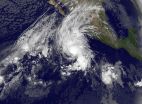(Press-News.org) For the first time, researchers have shown that practising mindfulness meditation or being involved in a support group has a positive physical impact at the cellular level in breast cancer survivors.
A group working out of Alberta Health Services' Tom Baker Cancer Centre and the University of Calgary Department of Oncology has demonstrated that telomeres – protein complexes at the end of chromosomes – maintain their length in breast cancer survivors who practise meditation or are involved in support groups, while they shorten in a comparison group without any intervention.
Although the disease-regulating properties of telomeres aren't fully understood, shortened telomeres are associated with several disease states, as well as cell aging, while longer telomeres are thought to be protective against disease.
"We already know that psychosocial interventions like mindfulness meditation will help you feel better mentally, but now for the first time we have evidence that they can also influence key aspects of your biology," says Dr. Linda E. Carlson, PhD, principal investigator and director of research in the Psychosocial Resources Department at the Tom Baker Cancer Centre.
"It was surprising that we could see any difference in telomere length at all over the three-month period studied," says Dr. Carlson, who is also a U of C professor in the Faculty of Arts and the Cumming School of Medicine, and a member of the Southern Alberta Cancer Institute. "Further research is needed to better quantify these potential health benefits, but this is an exciting discovery that provides encouraging news."
The study was published online today in the journal Cancer. It can be found at: http://onlinelibrary.wiley.com/doi/10.1002/cncr.29063/full
A total of 88 breast cancer survivors who had completed their treatments for at least three months were involved for the duration of the study. The average age was 55 and most participants had ended treatment two years prior. To be eligible, they also had to be experiencing significant levels of emotional distress.
In the Mindfulness-Based Cancer Recovery group, participants attended eight weekly, 90-minute group sessions that provided instruction on mindfulness meditation and gentle Hatha yoga, with the goal of cultivating non-judgmental awareness of the present moment. Participants were also asked to practise meditation and yoga at home for 45 minutes daily.
In the Supportive Expressive Therapy group, participants met for 90 minutes weekly for 12 weeks and were encouraged to talk openly about their concerns and their feelings. The objectives were to build mutual support and to guide women in expressing a wide range of both difficult and positive emotions, rather than suppressing or repressing them.
The participants randomly placed in the control group attended one, six-hour stress management seminar.
All study participants had their blood analysed and telomere length measured before and after the interventions.
Scientists have shown a short-term effect of these interventions on telomere length compared to a control group, but it's not known if the effects are lasting. Dr. Carlson says another avenue for further research is to see if the psychosocial interventions have a positive impact beyond the three months of the study period.
Allison McPherson was first diagnosed with breast cancer in 2008. When she joined the study, she was placed in the mindfulness-based cancer recovery group. Today, she says that experience has been life-changing.
"I was skeptical at first and thought it was a bunch of hocus-pocus," says McPherson, who underwent a full year of chemotherapy and numerous surgeries. "But I now practise mindfulness throughout the day and it's reminded me to become less reactive and kinder toward myself and others."
Study participant Deanne David was also placed in the mindfulness group.
"Being part of this made a huge difference to me," she says. "I think people involved in their own cancer journey would benefit from learning more about mindfulness and connecting with others who are going through the same things."
INFORMATION:
The research was funded by the Alberta Cancer Foundation and the Canadian Breast Cancer Research Alliance.
Calgary-area cancer patients can access information about Alberta Health Services programs in both mindfulness meditation and supportive expressive therapy, as well as other support programs at the Tom Baker Cancer Centre, by calling 403-355-3207.
Alberta Health Services is the provincial health authority responsible for planning and delivering health supports and services for more than four million adults and children living in Alberta. Its mission is to provide a patient-focused, quality health system that is accessible and sustainable for all Albertans.
The University of Calgary is a leading Canadian university located in the nation's most enterprising city. The university has a clear strategic direction – "Eyes High" – to become one of Canada's top five research universities by 2016, grounded in innovative learning and teaching and fully integrated with the community of Calgary. For more information, visit ucalgary.ca.
Introducing competing "biosimilar" versions of complex biologic drugs used to treat illnesses such as cancer and rheumatoid arthritis could cut spending on biologics in the United States by $44 billion over the next decade, according to new analysis from the RAND Corporation.
While biologics have advanced medical treatment for many conditions, they often are expensive and patient copays for some biologics can be several thousand dollars per year. In 2011, eight of the top 20 drugs in the United States in terms of sales were biologics and the annual spending on the drugs ...
BOSTON—New research reports that preoperative pain and depressive symptoms in older adults place them at greater risk of delirium following surgery. According to the findings published today in The Lancet Psychiatry journal, both pain and depression are independent and interactive risk factors for delirium, suggesting a cumulative effect.
Individuals with delirium experience a sharp decline in attention and mental function. Older adults are especially susceptible to delirium following surgery, occurring in up to 51% of surgical patients 65 and older. Moreover, depression ...
Clemson researchers find that blending movement and computer programming supports girls in building computational thinking skills, according to an ongoing study funded by the National Science Foundation and emerging technology report published in journal Technology, Learning and Knowledge.
Even with increasing demands for computationally savvy workers, there is a lack of representation among women in science, technology, engineering and mathematics fields (STEM), the researchers say.
"We want more diverse faces around the table, helping to come up with technological ...
Aging is the most significant and universal risk factor for developing neurodegenerative diseases, such as amyotrophic lateral sclerosis (ALS) and Alzheimer's, Parkinson's and Huntington's diseases. This risk increases disproportionately with age, but no one really knows why.
Now a team of scientists from Northwestern University, Proteostasis Therapeutics, Inc. and Harvard University has uncovered some clues. The researchers are the first to find that the quality of protective genes called molecular chaperones declines dramatically in the brains of older humans, both ...
Roughly one-third of the 700,000 United States troops who fought in the 1990-1991 Persian Gulf War have subsequently developed a distinct set of chronic health problems, dubbed Gulf War illness. Their symptoms, from fatigue, muscle pain and weakness to decreased cognitive function and gastrointestinal and skin problems, persist decades after the conflict.
In a study published in the Nov. 1 issue of Neural Computation, researchers at the University of California, San Diego School of Medicine report that a high quality brand of coenzyme Q10 (CoQ10) – a compound ...
NOAA's GOES-West satellite captured an image of Hurricane Vance and a much smaller developing low pressure area in the Eastern Pacific Ocean on Nov. 3. Vance's tropical-storm force winds extended to about 250 miles in diameter.
NOAA's GOES-West satellite captured an infrared image of the Eastern Pacific that showed Hurricane Vance was a couple of times larger than the developing low pressure area known as System 94E to the southeast of the hurricane. In the GOES image, taken Nov. 3 at 1200 UTC (7 a.m. EST/4 a.m. PST) clouds and showers extending from Vance's northern ...
Women are significantly underrepresented in many science, technology, engineering, and math (STEM) fields, and attempts to understand why have only resulted in disagreement among researchers, the lay public, and policymakers. In a comprehensive new report, an interdisciplinary team of psychological scientists and economists aims to cut through the confusion, synthesizing available research and providing a host of new analyses to identify the factors that drive women's underrepresentation in STEM. Their analyses show that, despite many differences between the sexes prior ...
New York | Heidelberg, 3 November 2014 -- A new theoretical work establishes a long-sought-after connection between nuclear particles and electromagnetic theories. Its findings suggest that there is an equivalence between generalised Casimir forces and those that are referred to as weak nuclear interactions between protons and neutrons. The Casimir forces are due to the quantisation of electromagnetic fluctuations in vacuum, while the weak nuclear interactions are mediated by subatomic scale particles, originally called mesons by Yukawa. These findings by Barry Ninham ...
This news release is available in French. A team of researchers from Inserm led by Paul Hofman (Inserm Unit 1081/University of Nice) has just made a significant advance in the area of early diagnosis of invasive cancers. In a study which has just been published in the journal PLOS ONE, the team shows that it is possible to detect, in patients at risk of developing lung cancer, early signs, in the form of circulating cancer cells, several months, and in some cases several years, before the cancer becomes detectable by CT scanning. This warning could play a key role in ...
WASHINGTON, Nov. 3, 2014 — As Carl Sagan famously said, "We are made of star stuff." It's a mind-boggling thought, but what exactly did he mean? Ahead of Sagan's birthday on November 9th, Reactions teamed up with the American Association of Chemistry Teachers (AACT) and best-selling author Sam Kean to explain the chemistry behind this iconic quote. Watch our latest episode to find out how many of the atoms that make up you (and everything else) were forged in the nuclear cores of stars billions of years ago. Watch the video here: http://youtu.be/2bm479V8qPs.
INFORMATION:
Kean's ...


